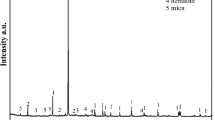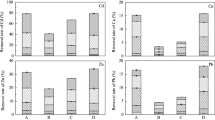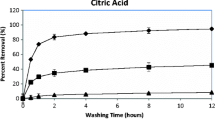Abstract
A multi-step soil washing test using a typical chelating agent (Na2EDTA), organic acid (oxalic acid), and inorganic weak acid (phosphoric acid) was conducted to remediate soil contaminated with heavy metals near an arsenic mining area. The aim of the test was to improve the heavy metal removal efficiency and investigate its influence on metal fractionation and the spectroscopy characteristics of contaminated soil. The results indicated that the orders of the multi-step washing were critical for the removal efficiencies of the metal fractions, bioavailability, and potential mobility due to the different dissolution levels of mineral fractions and the inter-transformation of metal fractions by XRD and FT-IR spectral analyses. The optimal soil washing options were identified as the Na2EDTA-phosphoric-oxalic acid (EPO) and phosphoric-oxalic acid-Na2EDTA (POE) sequences because of their high removal efficiencies (approximately 45 % for arsenic and 88 % for cadmium) and the minimal harmful effects that were determined by the mobility and bioavailability of the remaining heavy metals based on the metal stability (I R ) and modified redistribution index (\( {U}_{ts}^{{\textstyle '}} \)).





Similar content being viewed by others
References
Dermont G, Bergeron M, Mercier G, Richer-Lafleche M (2008) Soil washing for metal removal: a review of physical/chemical technologies and field applications. J Hazard Mater 152:1–31
Drahota P, Grösslová Z, Kindlová H (2014) Selectivity assessment of an arsenic sequential extraction procedure for evaluating mobility in mine wastes. Anal Chim Acta 839:34–43
Finžgar N, Leštan D (2007) Multi-step leaching of Pb and Zn contaminated soils with EDTA. Chemosphere 66:824–832
Griffiths RA (1995) Soil-washing technology and practice. J Hazard Mater 40:175–189
Gusiatin ZM, Klimiuk E (2012) Metal (Cu, Cd and Zn) removal and stabilization during multiple soil washing by saponin. Chemosphere 86:383–391
Hakanson L (1980) An ecological risk index for aquatic pollution control. A sedimentological approach. Water Res 14:975–1001
Han FX, Banin A (1999) Long-term transformation and redistribution of potentially toxic heavy metals in arid-zone soils: II. Incubation at the field capacity moisture content. WaterAirSoil Poll 114:221–250
Han F, Banin A, Kingery W, Triplett G, Zhou L, Zheng S, Ding W (2003) New approach to studies of heavy metal redistribution in soil. Adv Environ Res 8:113–120
Houben D, Evrard L, Sonnet P (2013) Mobility, bioavailability and pH-dependent leaching of cadmium, zinc and lead in a contaminated soil amended with biochar. Chemosphere 92:1450–1457
Jang M, Hwang JS, Choi SI, Park JK (2005) Remediation of arsenic-contaminated soils and washing effluents. Chemosphere 60:344–354
Jang M, Hwang JS, Choi SI (2007) Sequential soil washing techniques using hydrochloric acid and sodium hydroxide for remediating arsenic-contaminated soils in abandoned iron-ore mines. Chemosphere 66:8–17
Kim EJ, Baek K (2015) Enhanced reductive extraction of arsenic from contaminated soils by a combination of dithionite and oxalate. J Hazard Mater 284:19–26
Kim EJ, Lee JC, Baek K (2015) Abiotic reductive extraction of arsenic from contaminated soils enhanced by complexation: arsenic extraction by reducing agents and combination of reducing and chelating agents. J Hazard Mater 283:454–461
Liu CC, Chen GB (2013) Reclamation of cadmium-contaminated soil using dissolved organic matter solution originating from wine-processing waste sludge. J Hazard Mater 244:645–653
Madejova J, Komadel P (2001) Baseline studies of the clay minerals society source clays: infrared methods. Clay Clay Miner 49:410–432
Manning BA, Goldberg S (1996) Modeling competitive adsorption of arsenate with phosphate and molybdate on oxide minerals. Soil Sci Soc Am J 60:121–131
Mulligan CN, Yong RN, Gibbs BF (2001) Remediation technologies for metal-contaminated soils and groundwater: an evaluation. Eng Geol 60:193–207
Nowack B, Schulin R, Luster J (2010) Metal fractionation in a contaminated soil after reforestation: temporal changes versus spatial variability. Environ Pollut 158:3272–3278
O’Connell DW, Birkinshaw C, O’Dwyer TF (2008) Heavy metal adsorbents prepared from the modification of cellulose: a review. Bioresource Technol 99:6709–6724
Oh SY, Yoon MK, Kim IH, Kim JY, Bae W (2011) Chemical extraction of arsenic from contaminated soil under subcritical conditions. Sci Total Environ 409:3066–3072
Onken B, Adriano D (1997) Arsenic availability in soil with time under saturated and subsaturated conditions. Soil Sci Soc Am J 61:746–752
Oustan S, Heidari S, Neyshabouri M, Reyhanitabar A, Bybordi A (2011) Removal of heavy metals from a contaminated calcareous soil using oxalic and acetic acids as chelating agents. International Conference on Environment Science and Engineering IPCBEE 8:152–155
Qiu R, Zou Z, Zhao Z, Zhang W, Zhang T, Dong H, Wei X (2010) Removal of trace and major metals by soil washing with Na2EDTA and oxalate. J soil sediment 10:45–53
Rauret G, Lopez-Sanchez J, Sahuquillo A, Rubio R, Davidson C, Ure A, Quevauviller P (1999) Improvement of the BCR three step sequential extraction procedure prior to the certification of new sediment and soil reference materials. J Environ Monitor 1:57–61
Shim J, Shea PJ, BT O (2014) Stabilization of heavy metals in mining site soil with silica extracted from corn cob. Water Air Soil Pollut 225:1–12
Smedley P, Kinniburgh D (2002) A review of the source, behaviour and distribution of arsenic in natural waters. Appl Geochem 17:517–568
Sparks DL (2003) Environmental soil chemistry. Academic Press, Cambridge
Tokunaga S, Hakuta T (2002) Acid washing and stabilization of an artificial arsenic-contaminated soil. Chemosphere 46:31–38
Torres LG, Lopez RB, Beltran M (2012) Removal of As, Cd, Cu, Ni, Pb, and Zn from a highly contaminated industrial soil using surfactant enhanced soil washing. Physics and Chemistry of the Earth, Parts A/B/C 37:30–36
Tsang DC, Hartley NR (2014) Metal distribution and spectroscopic analysis after soil washing with chelating agents and humic substances. Environ Sci Pollut R 21:3987–3995
Udovic M, Domen L (2010) Fractionation and bioavailability of Cu in soil remediated by EDTAleaching and processed by earthworms. Environ Sci Pollut Res 17:561–570
Usero J, Gamero M, Morillo J, Gracia I (1998) Comparative study of three sequential extraction procedures for metals in marine sediments. Environ Int 24:487–496
Van Herreweghe S, Swennen R, Vandecasteele C, Cappuyns V (2003) Solid phase speciation of arsenic by sequential extraction in standard reference materials and industrially contaminated soil samples. Environ Pollut 122:323–342
Vithanage M, Rajapaksha AU, Wijesekara H, Weerarathne N, Ok YS (2014) Effects of soil type and fertilizer on As speciation in rice paddy contaminated with As-containing pesticide. Environ Earth Sci 71:837–847
Zhang W, Huang H, Tan F, Wang H, Qiu R (2010) Influence of EDTA washing on the species and mobility of heavy metals residual in soils. J Hazard Mater 173:369–376
Acknowledgments
This work was supported by the Research Fund for the Doctoral Program of Higher Education (20120003110033). The authors would like to extend special thanks to the editor and the anonymous reviewers for their constructive comments and suggestions in improving the quality of this paper.
Author information
Authors and Affiliations
Corresponding author
Additional information
Responsible Editor: Philippe Garrigues
Rights and permissions
About this article
Cite this article
Wei, M., Chen, J. Influence of multi-step washing using Na2EDTA, oxalic acid and phosphoric acid on metal fractionation and spectroscopy characteristics from contaminated soil. Environ Sci Pollut Res 23, 23123–23133 (2016). https://doi.org/10.1007/s11356-016-7542-z
Received:
Accepted:
Published:
Issue Date:
DOI: https://doi.org/10.1007/s11356-016-7542-z




